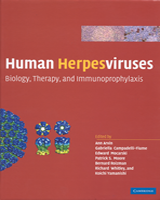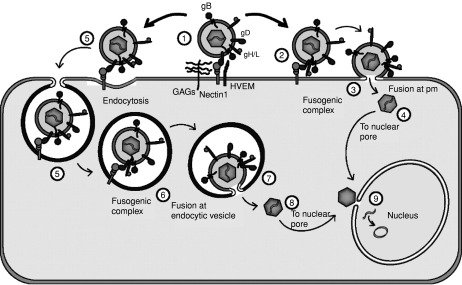From: Chapter 7, Entry of alphaherpesviruses into the cell

NCBI Bookshelf. A service of the National Library of Medicine, National Institutes of Health.

Schematic drawing of HSV entry. Entry can occur either by endocytosis (pathway at the left), or by fusion at the plasma membrane (pathway at the right). Following attachment to cells, gD binds to a cellular receptor (frame 1), and presumably following a conformational change it recruits the glycoproteins B, H and L in an active fusogenic complex (frame 2), triggering the fusion between viral envelope and cellular plasma membrane (frame 3). The naked nucleocapsids are transported to the nucleus (frames 4 and 9). In a cell line-dependent manner or with modified forms of the receptor (see text for details) bound virions can enter cells by endocytosis (frame 5). It is conceivable that at this stage the four fusogenic glycoproteins are in a non-fusion-active form. Following acidification/maturation of the endocytic vesicles, a fusogenic complex may form (frame 6) and fusion ensue between the virion envelope and the vesicle membrane (frame 7). Nucleocapsids delivered to the cytoplasm are transported to the nucleus (frames 8 and 9).
From: Chapter 7, Entry of alphaherpesviruses into the cell

NCBI Bookshelf. A service of the National Library of Medicine, National Institutes of Health.